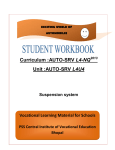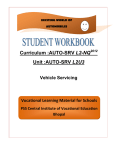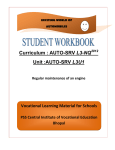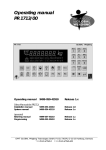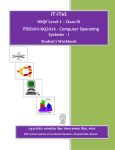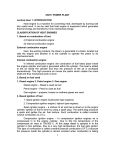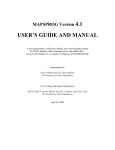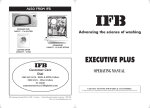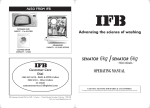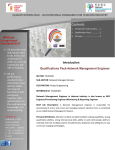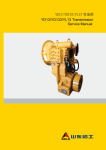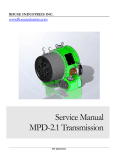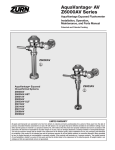Download Transmission System
Transcript
g EXCITING WORLD OF AUTOMOBILES Curriculum :AUTO-SRV L4-NQ2013 Unit :AUTO-SRV L4U6 Transmission System Vocational Learning Material for Schools PSS Central Institute of Vocational Education Bhopal AutoL4U6-NQ2013 Transmission System PREFACE Improving the parity of esteem between the general academic education and vocational education, is the policy priority of the Government of India. The National Vocational Education Qualification Framework (NVEQF) developed by the Ministry of Human Resource Development (MHRD), Government of India, is a descriptive framework that provides a common reference for linking various qualifications. It will be used for setting common principles and guidelines for a nationally recognized qualification system covering Schools, Vocational Education and Training Institutions, Technical Education Institutions, Colleges and Universities. The NVEQF will act as a translation device to make qualifications more understandable to employers, students and institutions. It will promote transparency of qualifications and facilitate learner’s mobility between different qualifications, thus encouraging lifelong learning. PSSCIVE has taken lead in development of learning material for the Automobile Sector for all level in collaboration with the Automobile Skill Development Corporation (ASDC). The present material contains activity related to Level L-4 for the Automobile service sector. This will fulfill the needs of the students willing to learn activities relating to the Automobile Service Sector. Any student/ entrepreneur willing to start an Automobile Service Sector can acquire the desired competencies with the help of this book. The book has been written by experts but reviewed by all the members of the group. I am grateful to the authors for the development of this book and to the members of the Working Group for their candid suggestions, during the development and review. Their names are given elsewhere. I appreciate efforts put in the by Dr. Saurabh Prakash, as the Project Coordinator of the Working Group in planning and organizing Meetings which led to the final form of this title. I shall be grateful to receive suggestions and observations from readers, which would help in bringing out a revised and improved version of this book. Bhopal June, 2013 Prof. R.B. Shivagunde Joint Director Pandit Sunderlal Sharma Central Institute of Vocational Education 2 AutoL4U6-NQ2013 Transmission System © Ministry of Human Resource Development 2013 Copyright protects this publication. Except for purposes permitted by the Copyright Act, reproduction, adaptation, electronic storage and communication to the public are prohibited without prior written permission. This student workbook was developed, with active involvement of the Automobile Skill Development Council (ASDC) keeping in view the National Occupation Standard (NOS) for Service Technician L4 developed by ASDC. This project for development of the student workbook was coordinated by the PSS Central Institute of Vocational Education, a constituent unit of National Council of Educational Research and Training, which is under the Ministry of Human Resource Development, Government of India. 3 AutoL4U6-NQ2013 Transmission System Student Details Student Name: _____________________________ Student Roll Number:________________________ Batch Start Date: __________________________ 4 AutoL4U6-NQ2013 Transmission System Contents About this workbook………………………………………….…………. Unit information…………….……………………………….…………… Elements and performance criteria…..………….…………………… Relevant knowledge and skills ..………….……………………….… Assessment plan……………………………………………...………… Introduction……………………………………………….……………… Session 1: Overhauling of clutch …….……………………………… Session 2: Servicing of propeller shaft, universal and slip joints … Session 3: Servicing of Differential unit and adjustment………..… Session 4: Automatics transmission system…………………………… Assessment ……………………………………………………………… Suggested Readings…………………………………………………… Contributors to the Workbook Development ……………………….. 6 7 8 9 9 10 11 18 21 27 29 31 32 5 AutoL4U6-NQ2013 Transmission System About this Workbook This workbook is to assist students with completing the Auto Sector L4U6NQ2013 unit of competency: Transmission system. Students should peruse the workbook in class or in their own time. This workbook contains sessions for imparting knowledge & skills on various basic aspects of the unit of competency. The workbook also includes information, exercises, and assessment activities to complete. The assessment plan has been included in the workbook to assist you in scheduling your time for completing the assignments. Each assessment activity is followed by a checklist for meeting the assessment criteria. The criteria will help you to ensure that you have fulfilled all of the assessment requirements to receive a ’competency’ grading/Certification by ASDC. 6 Transmission System AutoL4U6-NQ2013 Unit Information Unit name: Transmission System Unit code: Auto L4U6-NQ2013 Unit descriptor: This unit provides introductory knowledge & skills covering regular maintenance of transmission system of a vehicle. Students will be given a broad view of these important issues. Resource Required: · Notebooks, Pen, Pencil, Eraser. · Computer, Open Source Software for making digital presentation, LCD projector. · Sketches, pictures, animation and videos of transmission system and its components. · Posters for building awareness about these topics. Nominal hours: 30 Periods 7 AutoL4U6-NQ2013 Transmission System Elements and Performance Criteria · Elements define the critical learning outcomes of a unit of competency. · Performance criteria specify the level of performance required to demonstrate the achievement of the competency element. Element of knowledge Performance Criteria Importance of servicing of propeller shaft, universal and slip joints Importance of servicing of differential unit and adjustments · Able to do overhauling of clutch · inspect and lubricate the controls of the clutch system · Able to do servicing/ overhauling of propeller shaft, universal and slip joints · Able to do servicing and adjustment of differential unit Introduction to automatic transmission system, · Identify and understand automatic transmission system Importance of overhauling of clutch 8 AutoL4U6-NQ2013 Transmission System Relevant Knowledge and Skills 1. 2. Relevant Knowledge · Overhauling of clutch · Servicing of propeller/drive shaft, universal and slip joints · Servicing of differential unit and adjustments Skills Able to do/replace above items in a vehicle · · · · understand different components of clutch overhauling of the clutch Servicing of propeller/drive shaft, universal and slip joints Servicing of differential unit and adjustments Assessment Plan Session No. 1. 2. 3. Assessment method Due Date Completion Date Fill in the Blanks Fill in the Blanks Fill in the Blanks 9 AutoL4U6-NQ2013 Transmission System Introduction The oldest variant of the transmission system in India is the manual transmission that has undergone various modifications and alterations to form the present day automatic transmission. Transmission system in a vehicle helps to transmit mechanical power from the engine to give kinetic energy to the wheels. It is an interconnected system of engine, clutch plate, pressure plate, release bearing, gears, shafts, and other electrical gadgets that form a bridge to transfer power and energy from the engine to the wheels. The complete set up of the system helps to maintain the cruising speed of the vehicle without any disturbance to the car’s performance. In this Unit, you will develop an understanding of the transmission system. 10 Transmission System AutoL4U6-NQ2013 Session 1: Overhauling of clutch Relevant Knowledge In unit 3 we have discussed about maintenance and regular adjustments in clutch for efficient power transmission. When clutch runs nosily and clutch slips do not engage and disengage properly, gives jerking movement in engagement and as well as disengagement. Then it is necessary to overhaul the clutch. Mostly different types of clutches are used in today’s automobile Diaphragm clutch. Multi plate clutch and Centrifugal clutch with vero drive. Diaphragm clutch: In this type of clutch diaphragm spring is used instead of coil spring. This type of clutch is called as diaphragm clutch. Diaphragm clutch is small in size as compare to spring clutch and it transmits more torque as diaphragm exerts more force as compare to springs. Therefore it is advantageous to use diaphragm clutch instead of spring clutch. It is more compact means of storing energy, thus compact design results in smaller clutch housing. It is less affected by centrifugal force and it can withstand higher rotational speeds. Diaphragm acts as both clamping spring and release levers. Therefore many extra parts like release figure, pivot pins etc. can be eliminated. This clutch requires less maintenance compare to other types of clutches. Fig 1: Clutch Fig 2: View of clutch 11 AutoL4U6-NQ2013 Transmission System Activity 1: To overhaul the clutch used in 4 wheelers Tools required: Open, ring and box spanner etc. Procedure: 1. Place the vehicle on the level ground. 2. Remove the clutch linkage connection from the bell housing. 3. Raise the vehicle at a specific height. 4. Dismantle propeller shaft from companion flange of the gear box. 5. Loosen gearbox nut/bolt from clutch housing. 6. Mark the position of cover plate to the flywheel. 7. Loosen all the bolts of pressure assembly using diagonal method. 8. Remove the clutch plate and keep it on the work bench. Inspection of Clutch plate 1. Check for the oil leakage on the cutch plate, if oil leakage is there, then replace the oil seal on gear box or from crankshaft. 2. Place the clutch plate on clutch shaft. 3. Place the dial gauge on the clutch shaft. 4. Now inspect the radial run out of the clutch plate. 5. Allow the pointer to rest perpendicular to clutch plate, rotate the clutch plate and check radial run out if it is more than 2.0mm then replace the clutch plate. 6. Radial run out 7. Take the clutch plate and place it on the clutch shaft. 8. Take a marker to check the side of frictional lining and also check the bend of the clutch shaft. 9. Inspect the torsion split for breakage or slackness 10. Check the internal spline of clutch hub with clutch shaft external spline. Inspection of Flywheel frictional surface · Visual inspect frictional surface of flywheel, if lining/wear is traced then remove the fly wheel from the crankshaft · Inspect the pivot bearing · Skim the frictional surface of the flywheel on lath machine · Also check the ring gear of flywheel 12 AutoL4U6-NQ2013 Transmission System · Also check the internal thread of flywheel where pressure plate cover may be assembled Pressure plate 1. The frictional surface of the pressure plate has scratches and mounting on it. 2. If the pressure plate is distorted then we can do the skimming process by removing the little surface of the plate. 3. And after that we can increase the thickness of friction lining to accommodate the thickness. Diaphragm spring 1. 2. 3. 4. Inspect the diaphragm spring for torn finger and if it has cracks on it. Also we have to check the tension of the spring. Check the release bearing for wear, replace if it is worn out Inspect release bearing supporting , furculum and shaft To check the functioning 1. 2. 3. 4. 5. Take the pressure plate on the arbor press. Fix the pressure tester on it and slowly press it. And slowly press. Then slowly release its pressure will deflect the reading. The pressure should be in17/19 kg/cm2. Precaution 1. 2. 3. 4. Do not misplace the parts. Keep the removed nuts/bolts properly in the tray. Do not misplace the parts. Keep the removed nuts and bolts properly in the tray. 13 AutoL4U6-NQ2013 Transmission System Activity 2: To dismantle multiplate components used in two wheelers clutch and to inspect the Multiplate clutch consists of a number of clutch plates, where as single plate clutch has only one clutch plate. As the numbers of clutch plates are increased, the friction surface also increases. The increased number of friction surfaces in clutch increases the capacity of the clutch to transmit torque in automobiles. The plates are alternately fitted to the engine shaft and gear box shaft. They are firmly pressed by strong coil springs and assembled in housing. Each of the alternate plate slides in grooves on the flywheel and the other slides on splines on the pressure plate. Therefore, each alternate plate has inner and outer splines. The multipleate clutches operating condition may be dry or wet. When the clutch is operated in an oil bath, it is called a wet clutch. When the clutch is operated dry, it is called dry clutch. The wet clutches are generally used in conjunction with the automatic transmission automotives. Multiplate clutch works in the same way as the single plate clutch i.e. by operating the clutch pedal. The multiplate clutches are used in heavy commercial vehicles, automobiles, racing cars and motor cycles for transmitting high torque. Tools required: D.E ring spanner, D.E opera Spanner, screw driver Fig 3: Multiple Clutches Procedure: 1. Keep the vehicle on plane hard surface 2. Remove the connections of clutch cable 3. Loosen the drain nut and drain the oil 14 AutoL4U6-NQ2013 4. 5. 6. 7. 8. 9. 10. Transmission System Use specified spanner and remove clutch cover. Check clutch operating arm, return spring and clutch lifter rod Use special tool to compress clutch assembly Lock the clutch lug or clutch housing Loosen the cluster nut/housing nut. Slowly release the spring tension Dismount clutch assembly from the crankshaft Inspection Check the clutch plates –for distortion, scratches, wrapping Check the clutch plate thickness, if it is worn out then replace it Inspect the clutch housing for cut and wear Check the pressures plate for distortion, scratches on lining on the pressure plate 5. Check the clutch springs for – tension, height, bend 1. 2. 3. 4. Assembly 1. 2. 3. 4. Assemble the clutch in reverse order of disassembly Fix the side cover add lubricating oil Connect the clutch cable connection Set the free play Precaution 1. 2. 3. 4. Fix the spanner properly Handle the parts carefully Do not misplace the circlip and woodruff key Keep the removed out bolts in the tray. Activity 4: To inspect hard servicing of centrifugal clutch A centrifugal clutch is a clutch that uses centrifugal force to connect two concentric shafts, with the driving shaft nested inside the driven shaft. The input of the clutch is connected to the engine crankshaft while the output may drive a shaft, chain, or belt. As engine revolutions per minute increase, weighted arms in the clutch swing outward and force the clutch to engage. 15 AutoL4U6-NQ2013 Transmission System The most common types have friction pads or shoes radially mounted that engage the inside of the rim of housing. On the centre shaft there are an assorted number of extension springs, which connect to a clutch shoe. When the central shaft spins fast enough, the springs extend causing the clutch shoes to engage the friction face. fuel-powered model cars and low power Another type used in racing karts has friction and clutch disks stacked together like a motorcycle clutch. The weighted arms force these disks together and engage the clutch. When the engine reaches a certain speed, the clutch activates, working somewhat like a continuously variable transmission. As the load increases, the speed drops, disengaging the clutch, letting the speed rise again and reengaging the clutch. If tuned properly, the clutch will tend to keep the speed at or near the torque peak of the engine. Fig 4: Centrifugal clutch Tools required: DE open spanner, DE ring Spanner Procedure 1. 2. 3. 4. 5. 6. 7. 8. Keep the vehicle as plane hard surface. Observed and remove the cover Then remove the bolt Then take if ring sparer and unscrew the nuts Remove the pressure plate Then remove centrifugal pals Take circles per and remove circles Then remove gravitation shoos and keep comporest on work beach and inspect then. 16 AutoL4U6-NQ2013 Transmission System Inspection Shoe and liner · Check it for wear and bear. · Check for centrifugal weight Belt 1. Check the belt for wear off or other crack 2. See the belt for tension 3. Inspect the clutch return spray Centrifugal spring 1. 2. 3. 4. Check the centrifugal spring for tension Friction material on weight (cen centrifugal) In spec Bell housing for cracks Check pivot for free movement of centrifugal water Report 1. Frictional liner are 2. The bushes are 3. The spring tension is more Precaution 1. Handle the parts carefully 2. Fix the spanners properly 3. Do not misplace bush, keep it properly. 17 AutoL4U6-NQ2013 Transmission System Session 2: Servicing of propeller shaft, universal and slip joints Related Knowledge Propeller shaft: Where the engine and axles are separated from each other, as on fourwheel-drive and rear-wheel-drive vehicles, it is the propeller shaft that serves to transmit the drive force generated by the engine to the axles. The longer the shaft, the more liable it is to bend, and bending is further promoted when rotation is applied causing vibrations and resulting in an increase in noise. Fig 5: Propeller shaft Drive shaft A drive shaft is an elongated round shaft, usually made of steel that runs from the engine to gears that turn the wheels of a vehicle. 18 AutoL4U6-NQ2013 Transmission System Fig 6: Front wheel drive shaft Drive shafts are carriers of torque. To allow for variations in the alignment and distance between the driving and driven components, drive shafts frequently incorporate one or more universal joints, jaw couplings or rag joints, and sometimes a splined joint. Slip Joint A slip joint is a mechanical connection between two elements that allows for motion but not disconnection between the components. This is done to keep Fig 7: Slip Joint the components from becoming separated, even though they maintain their own separate functions. 19 AutoL4U6-NQ2013 Transmission System Universal Joint A universal joint, is a joint or coupling in a rigid rod that allows the rod to 'bend' in any direction, and is commonly used in shafts that transmit rotary motion. It consists of a pair of hinges located close together, oriented at 90° to each other, connected by a cross shaft. Fig 8: Universal joint 20 AutoL4U6-NQ2013 Transmission System Session 3: Servicing of differential unit and adjustments Related Knowledge Differential unit A differential is a device employing gears, capable of transmitting torque and rotation through three shafts. It transfer the power while in turning to the respective wheels. It consist crown gear, sun gear and star gear. Why You Need a Differential A vehicle wheel rotates at different speeds, especially when turning. Each wheel travels a different distance through the turn, and that the inside wheels travel a shorter distance than the outside wheels. Since speed is equal to the distance travelled divided by the time it takes to go that distance, the wheels that travel a shorter distance travel at a lower speed. Also note that the front wheels travel a different distance than the rear wheels. . Fig 9: Differential unit Fig 10: Differential view 21 AutoL4U6-NQ2013 Transmission System Fig 11: Differential section Differential The differential has three jobs: · To transfer the engine power through gearbox and propeller shaft to wheels. · To act as the final gear reduction in the vehicle, slowing the rotational speed of the transmission one final time before it hits the wheels · To transmit the power to the wheels while allowing them to rotate at different speeds while taking a turn. Activity 1: To overhaul the differential unit and carry out the necessary adjustments. Material required: Cotton (Dhoti), oil, kerosene, cleaning brush, metal tray. Procedure: 1. Drain off the oil from differential unit & open the Cover. 2. Disconnect the propeller shaft from the companion flange of pinion drive. 3. Disconnect the half axle shaft from the differential housing. 4. Open the complete cage assembly 5. Open both side of side caps and remove the crown star gear and sun gears. 6. Mark the position of all parts carefully for their easy reassembly in their original position. 22 AutoL4U6-NQ2013 Transmission System 7. Check crown wheel, sun gears, star gears teeth if it is broken replace the gears. Change all the brass washers. 8. Keep the caps and shims carefully as the control clearance between two moving parts. 9. Pull out the companion flange from pinion drive. 10. Now slowly tap the pinion shaft from outside the casing, the pinion will come out with spacer and two bearing. 11. Mark the position of pinion and no. of shims. Inspection 1. Inspect the bearing, if they are badly worn out /do not run freely, replace them. 2. Inspect the condition of all the gears teeth’s for roughness, chipping, cracking. 3. Put the new oil seals/gaskets, brass washer 4. To check the tooth contact 1. To check the tooth contacts apply the precision blue or red oxide paste. 2. Apply the above mentions pastes to the crown wheel teeth’s. 3. Apply the grease on both the side of the teeth equally. 4. And then rotate the pinion check the tooth contact. 5. If the tooth contact is improper the do the following adjustments. Adjustments in Differential unit 1. If there is heavy face contact then remove the shims from the pinion from bottom from the pinion downward. 2. If there is heavy flank, contact adds the shims in the pinion and take the pinion towards crown wheel at specific height. 3. If there is heavy toe contact then remove the shims from right hand side and add shims towards left hand side. 4. If there is heavy hill contact adds the shims towards crown wheel and takes the crown wheel towards pinion. 5. In some cases outer adjustments bolt with chuck nut also provided to support crown and final drive. 23 AutoL4U6-NQ2013 Transmission System Assembly 1. Fix the thrust washers, shims and distance pierces properly in correct position and reassemble the differential unit. 2. Check the end play of pinion shaft moved up and down. 3. Adjust the clearance to the proper value by means of shims and adjusting nut. 4. Check all the clearance of the tooth contact between the crown wheel & pinion. 5. While doing the adjustment you have to take care of backlash gap. 6. Backlash is gap between two meshing teeth of gear Check the backlash in final drive After assembly the differential unit, · Place the telescopic end of dial gauge on the crown wheel tooth, set dial gauge to zero · Now without turning the pinion shaft, move the crown wheel backlash will be noted on the dial gauge · The Backlash of pinion & crown wheel should not exceed 0.15 to 1.18mm. · To adjust the backlash, tighten the side check nuts in 4:1 ratio · Backlash between sun gear and star pinion · Place the dial gauge telescopic end on sun gear tooth · Rotate the sun gear without turning star pinion and take down the reading from dial gauge Important points Ø The backlash of sun gears & planetary gears should not exceed 0.10 to 0.20mm. Ø If there is more backlash, change the thrust pad with more thickness Ø If there is less backlash, change the thrust pad with less thickness Ø Also check the radial run out of crown wheel , it should not exceed more than 0.0025mm. 24 AutoL4U6-NQ2013 Transmission System Ø Check the internal spline of sun gear and external spline of half axle shaft for stripping Ø Check the gears at the other end of the half axle shaft Precaution 1. 2. 3. 4. 5. Fix the spanner properly. Do the tooth contact properly. Check/Inspect the parts thoroughly. Wear appron and shoes, etc. Replace all the oil seals or gaskets. Working of Differential: Input torque is applied to the ring gear (blue), which turns the entire carrier (blue), providing torque to both side gears (red and yellow), which in turn may drive the left and right wheels. If the resistance at both wheels is equal, the planet gear (green) does not rotate, and both wheels turn at the same rate. Fig12: Differential at work • If the left side gear (red) encounters resistance, the planet gear (green) rotates about the left side gear, in turn applying extra rotation to the right side gear (yellow). 25 Transmission System AutoL4U6-NQ2013 Fig13: Differential at left not working Servicing of Differential Servicing of differential means regular interval of oil has to be changed with proper grade as per service manual. Replace the broken gear and brass washer or damaged portion if required Adjustment of differential Adjustment of differential can be done by various thickness of shim. Adjusting bolt is provided at outer side of cage assembly to adjust crown gear. 26 AutoL4U6-NQ2013 Transmission System Session 4: Introduction to the Automatic Transmission System Related Knowledge Automatic Transmission System In a nutshell, an automatic transmission is a transmission system that changes gears for you to prevent you from either stalling or redlining your engine. If you are the type of driver that gets fustered when you have a lot of things to concentrate on all at once, an automatic transmission takes a lot of the hassle out of driving. An automatic transmission uses a number of components to get the optimum amount of power from the engine to the wheels. An automatic transmission incorporates a torque converter, which takes the place of a clutch; a complex planetary gearing system that provides all the different ratios, and a hydraulic system of valves that regulate how the gears interact with each other. The fluid inside an automatic transmission system (known as automatic transmission fluid or ATF) is used not only for the hydraulics, but also as a lubricant and to prevent corrosion of the parts Fig 14: Automatic transmission We can say that an automatic transmission is an automobile gearbox that can change gear ratios automatically as the vehicle moves under varying conditions, thus freeing the driver from shifting of gears manually. 27 AutoL4U6-NQ2013 Transmission System Main components of an automatic transmission. 1. Converter housing case. 2. Oil pan 3. Extension Housing Types of Automatic transmission 1. Automated manual transmission(AMT) 2. Continuously variable transmission (CVT) 28 AutoL4U6-NQ2013 Transmission System Assessment Session: Transmission System A. Answer the following questions (Use additional sheets of paper, if necessary) 1. What is the function of differential unit ? 2. What is the importance and working of differential ? 3. What are the main parts of differential ? 4. How to adjust crown wheel and pinion clearance ? 5. What rotates the differential pinion shafts ? 6. To which gear half shaft splines connects? 7. What kind of joint is used to link differential with shaft & why ? 8. What are the lubricants commonly used in differential ? B. Fill in the blanks 1. If oil leakage is there, then __________the oil seal on gear box or from crankshaft. 2. Automatic transmission is an __________ gearbox that can change gear ratios automatically. 3. Differential unit transfer the power while in turning to the respective _________. 4. A centrifugal clutch is a ________ that uses centrifugal force to connect two concentric shafts 5. Transmission system in a vehicle helps to ________mechanical power from the engine to give kinetic energy to the wheels. Exercise: Assignment · List the types of clutch used in a vehicle Sr.No. Name of vehicle Type of clutch 29 AutoL4U6-NQ2013 Transmission System · Prepare a poster showing line drawing of clutch, differential unit, propeller shaft, universal and slip joints Session : Transmission System Checklist for Assessment Activity Use the following checklist to see if you’ve met all the requirements Part A Share importance of transmission system of a vehicle. Part B Discussed in class the following: · Why transmission system are necessary? · What are the steps to be followed while servicing of clutch? · What are the steps to be followed while servicing of differential? Performance standards/criteria covered by this assessment Performance standards Yes Able to explain importance of transmission system Able to list general steps during servicing of clutch No 30 AutoL4U6-NQ2013 Transmission System Suggested Reading Books Title Author Publisher Automobile Engineering Vol I Kirpal Singh Standard Publishers Automobile Engineering,Vol II Kirpal Singh Standard Publishers Text Book of Automobile Engineering R. K. Rajput Laxmi Publications Automobile Engineering R. K. Singal S. K. Kataria and Sons Automobile Engineering Theory Kapil Dev Computech Publications Automobile Engineering, K. M. Moeed S. K. Kataria and Sons Websites auto.indiamart.com/auto-technology www.automobileindia.com/consumer-guide/automobile-technology auto.indiamart.com/auto-technology books.google.com/books/about/Automobile_Engineering.html www.bikeadvice.org www.wikipedia.com www.shell.com/home/content/ind/products_services/on_the_road www.myfamilycar.com/classroom 31 AutoL4U6-NQ2013 Transmission System List of Contributors 1. 2. 3. 4. 5. 6. 7. 8. Mr. Sudhir Vishwakarma, Coordinator, Automobile Division, CRISP, Shyamla Hills, Bhopal, MP-462002 Prof.A.P.Verma, Retd.Prof. PSSCIVE,Bhopal Mr. Nagendra D. Kore, Vice Principal and HOD Automobile Technology Section, P.W Higher Secondary School, Khorlim- Mapusa, Goa, Mr. Dhirender C. Srivastava, Retd Divisional Manager (Technical) UTC, 2046 A Anand Bagh, Opp State Bank of India, Haldwani, UK263139 Mr. Vikas Gautam, Lecturer (Automobile), Govt. Sr. Sec. School. Morigate.New Delhi Mr.A.C.Deb, HOD, Automobile, Pusa Polytechnic, Pusa, New Delhi Sh. Deepak Shudhalwar, Assistant Professor, Department of Engineering & Technology, PSS Central Institute of Vocational Education, Bhopal, MP –462013 Dr. Saurabh Prakash, Head, Department of Engineering & Technology, PSS Central Institute of Vocational Education, Bhopal, MP –462013 Programme Coordinator 32
































